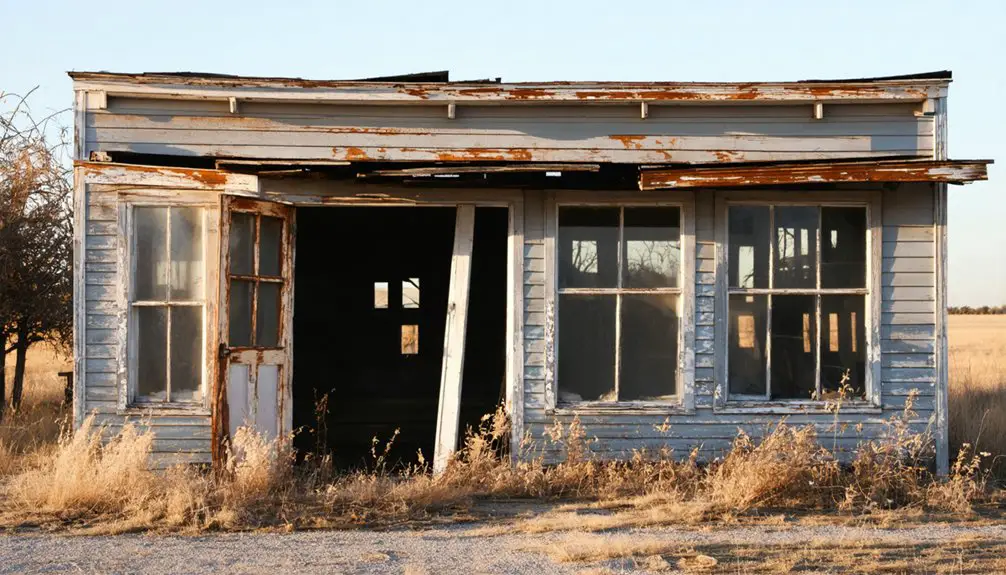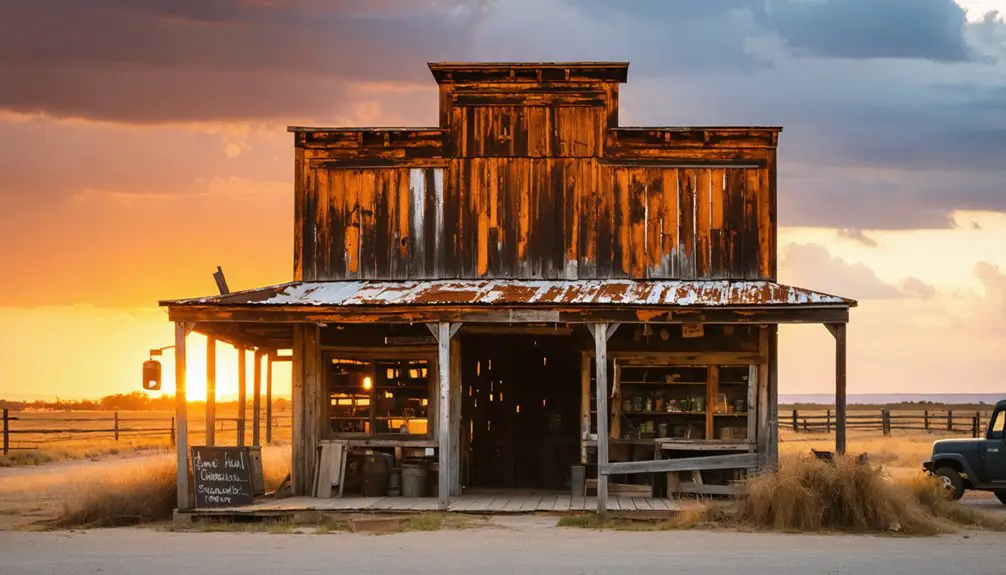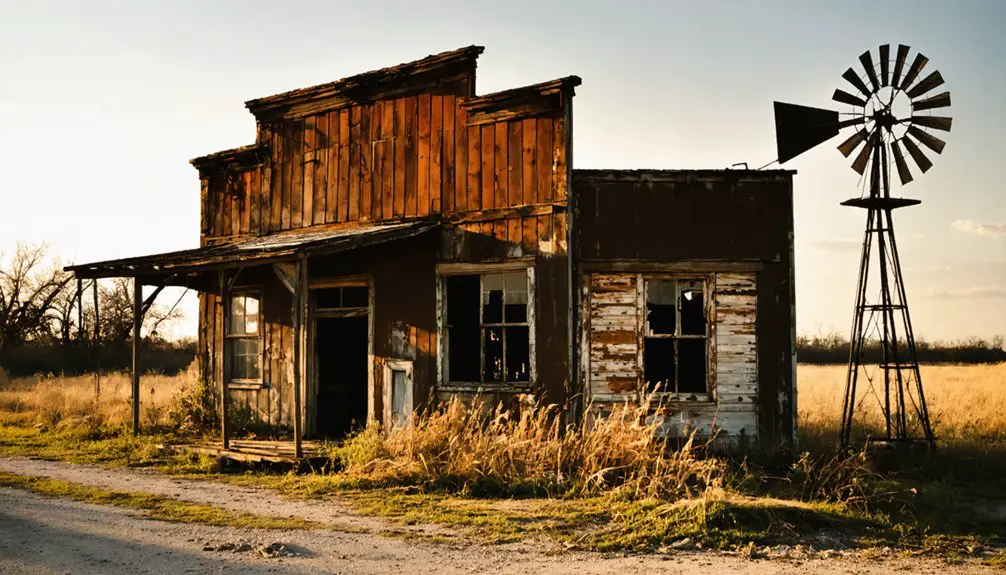You’ll find Curry, Texas submerged beneath Hubbard Creek Reservoir since 1962, but its story begins in 1847 as a farming settlement established by Samuel B. Patton. The discovery of oil in 1921 transformed this modest community into a bustling town of 1,100 residents with over forty businesses. When the oil wells ran dry in 1930, followed by the reservoir’s creation, Curry’s buildings and streets disappeared underwater. The town’s underwater remnants hold fascinating tales of boom-and-bust Texas history.
Key Takeaways
- Curry, Texas was established in 1847 and grew into a thriving oil boom town following the discovery of Currie Pool in 1921.
- At its peak in 1939, Curry had over 1,100 residents and forty businesses supported by the successful oil industry.
- The town’s decline began when oil wells ran dry in 1930, causing mass exodus and economic crisis.
- Essential services, including the post office, bank, and general store, closed as the population rapidly decreased.
- The town now lies submerged beneath Hubbard Creek Reservoir, with occasional glimpses visible during water level fluctuations.
The Birth of a Texas Frontier Settlement
As Texas was experiencing rapid frontier expansion in the mid-1800s, the settlement of Curry’s Creek emerged in 1847 when Samuel B. Patton established the first homestead. Much like the ancient spice trade that began millennia earlier, pioneers established vital trading routes through the region. The community stretched along five miles of Curry Creek, where several pioneering families built their homes and began cultivating the land.
You’ll find that early governance took shape quickly, with Patton becoming the first county judge of Blanco County. Notable settlers like Judge William Jones and Parson Daniel Rawls joined the community, bringing essential skills and industry to the frontier outpost. The settlement’s advancements included the construction of a local post office in 1863.
The settlement’s strategic location in east Kendall County attracted Texas’ original settlers, who saw potential in the creek’s resources. Within a decade, you’d have found a thriving community of over 100 residents, marking the successful birth of this Texas frontier settlement.
From Farmland to Black Gold: The Oil Boom Years
While Curry’s agricultural roots defined its early years, the discovery of the Currie Pool in December 1921 by Humphreys Oil Company transformed the region’s economic landscape.
You’ll find this oil discovery positioned strategically between Corsicana and Mexia, where 22 wells produced a remarkable 13,000 barrels daily at its peak.
The economic transformation brought by the Currie Pool’s superior 42 gravity oil led to:
The discovery of Currie Pool’s high-grade oil reshaped the local economy, ushering in an era of unprecedented growth and prosperity.
- Unprecedented profitability despite the field’s relatively small size
- Rapid shift from traditional farming to oil production
- Increased regional development and infrastructure improvements
- New employment opportunities for local residents
Like many Texas boom towns, Curry experienced a dramatic drop in oil prices to just pennies per barrel due to overproduction. This period marked a pivotal moment in Curry’s history, as the community experienced the same dramatic changes that would later sweep through other parts of Texas during the larger East Texas oil boom. Like many Texas communities during this era, Curry’s transition from agriculture to oil reflected the state’s broader economic transformation to industrialization between 1901 and the 1940s.
Peak Prosperity and Community Life
During Curry’s peak prosperity years, you’d find a bustling town transformed by oil wealth, with over forty businesses serving the daily needs of roughly 1,100 residents by 1939.
The once-quiet farming settlement had evolved into a vibrant community complete with a hospital, weekly newspaper, and essential services supporting both agriculture and petroleum industries. These industries brought modern amenities to the area, including electricity and indoor plumbing. Today, the incorporated town remains an active part of Stephens County.
You’d encounter frequent social gatherings centered around churches and local organizations, while agricultural fairs and oil celebrations brought together the town’s diverse mix of farmers, oil workers, and merchants.
Oil Wealth Transforms Town
The discovery of the Currie Pool in December 1921 transformed Curry from a quiet farming community into a bustling oil town, producing up to 13,000 barrels daily from 22 wells.
The economic transformation reshaped the landscape as oil exploration activities attracted diverse populations seeking opportunity and fortune. Like the East Texas Oil Field that would later emerge in 1930, Curry’s success demonstrated the region’s rich petroleum potential. Much like the earlier oil swindling era that plagued other boom towns, Curry faced its share of speculative schemes.
You’ll find that Curry’s oil wealth brought unprecedented development:
- New roads, housing, and utilities sprang up to accommodate the influx of workers
- Banks, stores, and entertainment venues flourished with increased disposable income
- Public services expanded through growing tax revenues from oil production
- Secondary industries emerged, including equipment manufacturing and transportation
The high-quality crude oil, with its superior 42 API gravity, made Curry’s production especially valuable, enabling rapid infrastructure growth and improved living standards for residents despite the field’s moderate size.
Daily Life During Boom
At its peak, life in Curry centered around a close-knit community of oil workers, plant employees, and their families who established structured daily routines shaped by industrial schedules.
You’d find workers heading to the carbon plant or oil fields while their children made their way to one of two segregated schools, where school attendance numbers showed about 60 students total.
Community activities revolved around these schools, which served as important social hubs for local families. Like in Cheapside, families maintained a strong sense of community through their local baseball team.
You’d see basic amenities supporting daily life, with commercial shops providing necessities for the working-class population.
While recreational options were limited, the social fabric was strengthened through shared experiences at church gatherings and local businesses, creating bonds among residents despite the racial stratification typical of early 20th-century Texas towns.
Similar to today’s small Texas towns, the local schools served as critical economic anchors for the community’s stability.
Community Events and Gatherings
While oil and agriculture drove Curry’s economy, community gatherings formed the heartbeat of local social life in the early 20th century.
You’d find residents regularly participating in community picnics, school events, and church gatherings that strengthened neighborly bonds. The town’s social fabric was woven through structured activities at two local schools serving 60 students, and religious institutions that hosted weekly services.
Key social events included:
- Annual harvest festivals celebrating agricultural milestones
- School plays, fairs, and graduation ceremonies
- Sunday church services and seasonal religious celebrations
- Business meetings during the 1920s oil boom at the carbon plant
These gatherings weren’t just social occasions – they were crucial platforms where residents exchanged news, made business deals, and maintained the close-knit community spirit that defined Curry’s peak years.
The Decline and Exodus

As you explore Curry’s rapid downfall in 1930, you’ll find that the town’s oil wells unexpectedly ran dry, triggering an immediate economic crisis.
The once-profitable oil field that had sustained nearly 300 residents could no longer support the community’s livelihood, forcing families to seek opportunities elsewhere.
Within months, Curry’s population dwindled dramatically as workers and their families abandoned their homes, leaving behind empty buildings and silent streets.
Oil Wells Run Dry
The devastating decline of Curry’s oil wells marked the beginning of the town’s downfall in the early 1980s.
You’d have witnessed production rates plummet by nearly 30% as wells that once gushed black gold succumbed to rapid depletion. The oil price crash below $50 per barrel forced widespread well abandonment, leaving behind a legacy of environmental impact that still haunts the region today.
The town’s fate was sealed by several critical factors:
- Wells began cannibalizing each other’s production due to over-drilling
- Previously profitable wells became economically unsustainable
- Contamination from abandoned wells threatened local water sources
- The “tsunami” of well shutdowns overwhelmed regulatory oversight
You can still see the remnants of this boom-to-bust cycle in Curry’s landscape, where orphaned wells stand as silent monuments to the town’s former prosperity.
Population Exodus Begins
Once Curry’s oil wells began failing, a devastating chain reaction of closures rippled through the community in the early 1980s.
You’d have witnessed the town’s essential services shutting down one by one – the post office, local bank, and general store all closed their doors.
The population decrease accelerated as families sought opportunities elsewhere, following the broader rural migration pattern toward urban centers.
Without replacement industries or new investment to sustain the local economy, Curry’s remaining residents faced increasing isolation.
The closure of the school dealt a particularly harsh blow, as families with children had little choice but to relocate.
Beneath the Waters: A Submerged Legacy
Beneath murky waters of Hubbard Creek Reservoir lies what remains of Curry, Texas – a symbol of the state’s complex relationship with water management and progress.
Though the exact location remains uncertain, underwater archaeology suggests remnants of the town persist beneath layers of sediment and time.
Hidden beneath Hubbard Creek’s depths, Curry’s ghostly remains endure, preserved in sediment like fragments of memory frozen in time.
You’ll find that Curry’s legacy lives on through cultural memory, despite its physical submersion:
- Foundation remnants and roadbeds may still exist underwater, though rarely visible
- Descendant families maintain connections through reunions and online communities
- Seasonal water fluctuations occasionally reveal glimpses of the submerged town
- Former residents’ stories preserve the town’s history, even as its physical traces fade
The reservoir’s waters now conceal this piece of Texas history, transforming a once-thriving community into an underwater time capsule.
Distinguishing Curry’s Place in Texas History

Although Curry’s physical remains now rest beneath Hubbard Creek Reservoir, its historical significance reflects broader patterns of rural Texas development during the late 19th and early 20th centuries.
You’ll find Curry’s cultural heritage mirrored in countless small Texas communities that emerged, flourished briefly, and vanished as economic tides shifted.
The town’s educational legacy is particularly telling – its segregated schools serving 60 students by 1903 paint a vivid picture of both social progress and racial division common to that era.
While Curry didn’t survive past 1941, its story isn’t one of simple failure but rather a reflection of the dynamic nature of Texas settlement patterns.
Like many of its contemporaries, Curry’s rise and fall illustrates the challenges rural communities faced amid rapid societal changes.
Frequently Asked Questions
Are There Any Known Photographs of Curry Before It Was Submerged?
Like a missing puzzle piece in Texas history, you won’t find published photos of Curry before its submergence. While Curry family portraits exist, no confirmed town-wide images survive in archives or collections.
What Specific Oil Companies Operated in the Curry Oilfield?
You’ll find Mobil Producing Texas & New Mexico and BASA Resources led oil production in Curry, while historic giants like Gulf, Humble Oil, Magnolia Petroleum, and Texaco shaped the field’s early company history.
Did Any Original Buildings Survive Relocation Before the Reservoir’s Creation?
Ever wonder what remains of once-thriving communities? You won’t find any original buildings from Curry – there’s no evidence of building preservation or successful relocation efforts before the reservoir submerged this historically significant site.
What Were the Primary Causes of Death Recorded in Curry?
You’ll find disease outbreaks like meningitis, typhoid, and tuberculosis were dominant killers, while industrial accidents from oil drilling, farming, and milling operations claimed lives throughout the settlement’s existence.
Were There Any Notable Crimes or Lawlessness During Curry’s Oil Boom?
You’d be amazed that while there’s no direct evidence of specific crimes in Curry’s oil boom, it likely followed typical boomtown crime trends with gambling, theft, and oil-related disputes.
References
- https://en.wikipedia.org/wiki/Curry
- https://www.txgenwebcounties.org/blanco/communities.html
- https://www.tshaonline.org/handbook/entries/curry-tx-stephens-county
- https://texashighways.com/travel-news/four-texas-ghost-towns/
- https://www.youtube.com/watch?v=T7hj1iweWi8
- https://www.tshaonline.org/handbook/entries/currys-creek-settlement
- https://www.texasescapes.com/TexasTowns/Curry-Texas.htm
- https://www.texasescapes.com/TOWNS/Texas_ghost_towns.htm
- https://en.wikipedia.org/wiki/List_of_ghost_towns_in_Texas
- https://txnavarr.genealogyvillage.com/towns/currie/index.htm



